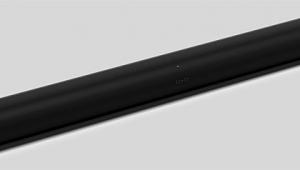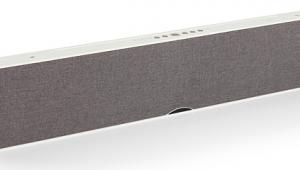Sony HT-ST7 Soundbar System Page 2

When fed 7.1-channel test tones, the system dedicated a driver to each channel. This was the assignment of channels to drivers, from left to right: front left, surround left, back surround left, center, back surround right, surround right, and front right. The center-channel tone sounded slightly higher in pitch than the others. In my listening room&mdashl;with the side walls heavily cluttered and at different distances—surround effects manifested themselves as greater spaciousness, loosening the soundbar’s hold on the soundstage but not moving far from it. A symmetrical setup with uncluttered side walls might have produced a different effect. Sweep tones played ridiculously loud uncovered a buzzy midbass resonance in the plastic back panel, but it was never audible with normal demo material at any volume.
 Family Resemblance
Family Resemblance
The HT-ST7’s voicing should be instantly familiar to anyone who’s heard Sony’s ES speaker line or the most recent Sony receivers including the STR-DN1040. A warm and ingratiating midrange sat between a clean and disciplined top end and a firm (and highly adjustable) bottom end. No, this soundbar didn’t sound exactly like Sony’s high-end speakers. But it seemed to share a common set of values—chief among them the notion that sound should be pleasant. This was especially true of the movie mode, which I could play quite loud—and I expect no less of a product tweaked by Oscar-winning sound designer Paul Ottoson, who worked on Zero Dark Thirty, The Hurt Locker, and Spider-Man 2. The Music and STD modes were more suitable for low to moderate levels, with most material prospering at the moderate end.
A Good Day to Die Hard (BD, DTS-HD Master Audio) gave me a chance to dial in the bass with a barrage of action-movie effects. It wasn’t hard. The first and most restrained of the three subwoofer modes—played from 6 to 8 on the 10-increment sub volume scale—provided the best soundbar/sub balance in my room and to my taste. This made male voices localizable in the sub, but intermittently and faintly. I soon got used to it and accepted it as a given. Likewise, voices seemed to have a faintly processed feel at first, but that was largely because I preferred the lowest of the three voice-level settings, making the surround effects—coming, you’ll recall, from the four drivers on either side of the center driver—relatively more prominent. Again, I soon got used to it, and that was easy because the overall sound was just so sweet and agreeable.
Texas Chainsaw (BD, DTS-HD MA) put the soundbar’s eager-to-please personality to the test with sudden noises, screaming, and of course the rampaging mechanical wail of the chainsaw. Reconciling effects with dialogue took a little fine-tuning, but I managed it without resorting to anything other than master volume adjustments. By the time I got to Madagascar 3 (BD, Dolby TrueHD), I wanted to retest my devotion to the most restrained settings in the dialogue level and subwoofer tone controls. But with such cleanly recorded vocals—as animated movies tend to have—there was no need to boost dialogue. And I still preferred the “crisp” bass mode because it did the best job of preventing the soundbar and sub from drifting apart. The system was at its best when they sounded like a single device.
 With just a few more HDMI connections, the soundbar became the only audio system connected. Movie mode was adequate for speaking voices on the evening news, though STD did more with less volume. In summer reruns of Saturday Night Live I didn’t bother to shift out of the Movie mode for the musical guests—I thought it provided a pretty good live-in-the-TV-studio sound. The soundbar provided its most memorable moments during Netflix binge-viewing of Star Trek: Deep Space Nine, as the Movie mode deftly juggled apocalyptic space battle scenes with intrigue and comedy on the space station. Maybe some other time I’ll favor you with my thousand-word essay on why this is the most conceptually inspired and brilliantly cast of the five Star Trek series. With the soundbar and sub meshing well, I developed a finer appreciation for the melodious voice of Avery Brooks as Commander Sisko.
With just a few more HDMI connections, the soundbar became the only audio system connected. Movie mode was adequate for speaking voices on the evening news, though STD did more with less volume. In summer reruns of Saturday Night Live I didn’t bother to shift out of the Movie mode for the musical guests—I thought it provided a pretty good live-in-the-TV-studio sound. The soundbar provided its most memorable moments during Netflix binge-viewing of Star Trek: Deep Space Nine, as the Movie mode deftly juggled apocalyptic space battle scenes with intrigue and comedy on the space station. Maybe some other time I’ll favor you with my thousand-word essay on why this is the most conceptually inspired and brilliantly cast of the five Star Trek series. With the soundbar and sub meshing well, I developed a finer appreciation for the melodious voice of Avery Brooks as Commander Sisko.
Bert the Master
Streaming Bluetooth from an iPad 2, I played Bert Jansch’s When the Circus Comes to Town. Bert is best known as a folk guitar god and ex-member of Pentangle, the folk supergroup. But this was my favorite version of him, Bert the master songwriter, perhaps his most overlooked talent, just tossing off one brilliant song after another. Despite the conversion into MP3 at 192 kilobits per second, the voice and guitar were surprisingly lifelike. I shifted between the music mode, with the tweeter/woofer pairs operating alone, and the STD mode, which added three of the center drivers. STD was less bright and could be played louder, which mitigated the crude lossy top end of MP3, but also pushed the stereo image inward toward the center.
Bluetooth and MP3 are both somewhat debased media, so I logged a few hours with CDs. (I didn’t connect a turntable, though the thought did occur.) Carlos Kleiber conducted the Vienna Philharmonic in one of the best-ever recordings of Beethoven’s Seventh Symphony from DG’s golden age of analog recording. I noted that the world-class string section sounded equally at home in the music or STD modes, though for the most concert-hall-like feeling, the more diffuse Movie mode made a surprise comeback and could be played considerably louder.
Stereo width is not any soundbar’s strong suit. But a vintage 1960s pingpong mix like Help! by the Beatles, with voices and instruments often at extreme left or right, got the most out of the soundbar’s limited width. The Music mode was widest, STD was second best, and I even tried the Football mode for a few seconds of the Fab Four at Shea Stadium Experience.

As a soundbar priced well in excess of a thousand bucks, the Sony HT-ST7 is going to face resistance. Some people just won’t pay that much for a soundbar. Those who do have that kind of money to spend may gravitate to other product categories.
But for some people, and in some rooms, a soundbar is the most logical audio-for-video solution, and there may be demand for a high-performing one with HDMI connectivity and lossless-surround support. After all, why should a savvy home theater buff lower his standards when a product with up-to-date technology and high performance is beckoning? This heavy metal bar, with its easy-to-live-with personality, provides a significant percentage of the home theater experience in a beautiful package. Strongly recommended.
Audio editor Mark Fleischmann is also the author of the annually updated book Practical Home Theater (quietriverpress.com).
- Log in or register to post comments




































































